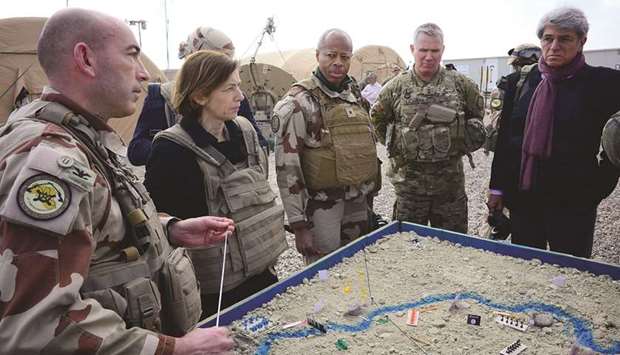French howitzer-guns deployed in the Euphrates Valley desert just inside Iraq stand ready to pour fury on Islamic State group diehards in their last holdout across the border in Syria.
Warplanes flash through the sky, followed seconds later by explosions on the Syrian side that send up a mushroom cloud.
“We’re less than 10 kilometres from the frontline here,” points out Colonel Francois-Regis Legrier.
He is the commander of Task Force Wagram, a French artillery group within the US-led military coalition that backs up Iraqi soldiers and the Syrian Democratic Forces (SDF) against the jihadists.
Dozens of 155-mm shells are lined up ready to be loaded onto three green-and-black Caesar gun-howitzers with a range of 40 kilometres. The SDF, a coalition of Kurdish and Arab fighters, announced a final push to retake the militant pocket in and around the village of Baghouz near the Iraqi border late Saturday, after a pause of more than a week to allow civilians to flee.
“The end is near,” is the message from France’s Defence Minister Florence Parly who visited the Task Force Wagram site in Al-Qaim from Baghdad aboard an American V-22 Osprey military aircraft.
“The terrorists are leaderless, without communications, in disarray, on the verge of collapse. So let’s finish off this fight,” the minister tells a group of some 40 French soldiers manning the outpost alongside 100 US troops.
Legrier, whose 68th regiment took part in the 2016 recapture from IS of the northern Iraqi city of Mosul, says there are “a few hundred fighters left in Baghouz, not more”.
“Mosul, that was a nine-month battle and 10,000 shells. On this front, it’s been four months and we’re at 3,500 rounds,” he says.
He points to challenges caused by frequent sandstorms and heavy rains.
Weather conditions have often grounded warplanes but artillery has been largely unaffected.
“At the end of last year, the pace was intense, we didn’t get much sleep,” explains Valentin, a 27-year-old lieutenant on his maiden overseas deployment.
The lieutenant and his comrades are being rotated out next week, probably for the last time, as the mission winds down.
“The territorial caliphate, which has not yet been wiped out, is being defeated,” Parly had said in the Iraqi capital last week, referring to the swathes of territory straddling Syria and Iraq seized by a rampant IS in 2014.
“We must continue the fight against IS and terrorism in the region because IS is probably in the process of reorganising underground and spreading out,” she said on her visit.
Since the launch of its Al-Qaim operations, codenamed Chammal, French forces have fired off more than 18,000 shells and conducted 1,500 air strikes in support of anti-IS fighters on the ground.
“Our forces have been playing their part in full,” Parly says in the desert.
But “the fight is not completely over,” she warns.”What we want to avoid at all costs is for Daesh (IS) to regroup in clandestine forms, threaten the region, disrupt its stabilisation, and also menace our countries.”

(From left) French Major of the Wagram Task Force Francois-Regis Legrier explains military positions on a sand map to French Defence Minister Florence Parly, French General Jean-Marc Vigilant, US Army General Paul La-camera, and French ambassador to Iraq Bruno Aubert, at a French artillery base near Al-Qaim in Iraq’s western Anbar province opposite Syria’s Deir Ezzor region.


